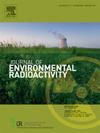Dynamic variation characteristics of 222Rn in typical karst cave systems in south China and their influencing factors
IF 2.1
3区 环境科学与生态学
Q3 ENVIRONMENTAL SCIENCES
引用次数: 0
Abstract
Radon (222Rn) gas is a natural tracer for air exchange between cave atmospheres and external environments. Investigating the spatiotemporal variation characteristics and controlling factors of its activity is crucial for revealing seasonal cycles and short-term fluctuation mechanisms of cave air exchange. Based on three years of continuous monitoring (from January 2018 to December 2020) of atmospheric 222Rn in Maomaotou Big Cave, Guilin, South China, this study systematically analyzes the spatiotemporal patterns and driving mechanisms of 222Rn activity concentrations. The cave exhibits two distinct seasonal gas circulation patterns: a degassing circulation mode in winter and spring and a gas recharge circulation mode in summer and autumn. Seasonal variations of 222Rn are primarily controlled by ventilation effects driven by temperature gradients between the cave interior and exterior. When external temperatures exceed cave temperatures, atmospheric stagnation promotes 222Rn accumulation; conversely, ventilation-induced dilution occurs when external temperatures drop below cave temperatures. Additionally, atmospheric precipitation significantly influences 222Rn activity concentrations, showing an inverse relationship where higher rainfall corresponds to lower 222Rn activity concentrations and vice versa. This phenomenon correlates with rainfall-induced soil moisture variations that regulate radon exhalation rates and subsequent diffusion processes. Furthermore, 222Rn activity concentrations also depend on the distribution of its parent radionuclide 226Ra in overlying soils and soil moisture content, which influences the radon dissolution and transport to the cave by dripwater. Through multifactorial analysis, this study elucidates synergistic mechanisms involving temperature gradients, precipitation, soil properties, and air exchange in regulating 222Rn dynamics. The findings provide critical scientific insights into cave gas dynamics and environmental effects, enhancing the understanding of subterranean air circulation patterns while offering theoretical support for cave environmental monitoring and health risk assessment.
华南典型溶洞系统中222Rn的动态变化特征及其影响因素
氡(222Rn)气体是洞穴大气与外部环境之间空气交换的天然示踪剂。研究其活动的时空变化特征及其控制因素,对于揭示洞穴空气交换的季节周期和短期波动机制具有重要意义。基于2018年1月- 2020年12月3年桂林毛茅头大洞大气222Rn的连续监测,系统分析了222Rn活动浓度的时空格局及其驱动机制。洞内气体季节性循环模式明显,冬春季为脱气循环模式,夏秋季为补气循环模式。222Rn的季节变化主要受洞内外温度梯度驱动的通风效应控制。当外部温度超过洞穴温度时,大气停滞促进222Rn的积累;相反,当外部温度低于洞穴温度时,通风引起的稀释就会发生。此外,大气降水显著影响222Rn活度浓度,呈现出高降雨量对应低222Rn活度浓度的反比关系,反之亦然。这一现象与降雨引起的土壤湿度变化有关,土壤湿度变化调节氡的呼出率和随后的扩散过程。此外,222Rn活性浓度还取决于其母体放射性核素226Ra在上覆土壤中的分布和土壤含水量,从而影响氡的溶解和通过水滴向洞穴的运输。通过多因素分析,本研究阐明了温度梯度、降水、土壤性质和空气交换在调节222Rn动力学中的协同机制。研究结果为洞穴气体动力学和环境效应提供了重要的科学见解,增强了对地下空气循环模式的认识,同时为洞穴环境监测和健康风险评估提供了理论支持。
本文章由计算机程序翻译,如有差异,请以英文原文为准。
求助全文
约1分钟内获得全文
求助全文
来源期刊

Journal of environmental radioactivity
环境科学-环境科学
CiteScore
4.70
自引率
13.00%
发文量
209
审稿时长
73 days
期刊介绍:
The Journal of Environmental Radioactivity provides a coherent international forum for publication of original research or review papers on any aspect of the occurrence of radioactivity in natural systems.
Relevant subject areas range from applications of environmental radionuclides as mechanistic or timescale tracers of natural processes to assessments of the radioecological or radiological effects of ambient radioactivity. Papers deal with naturally occurring nuclides or with those created and released by man through nuclear weapons manufacture and testing, energy production, fuel-cycle technology, etc. Reports on radioactivity in the oceans, sediments, rivers, lakes, groundwaters, soils, atmosphere and all divisions of the biosphere are welcomed, but these should not simply be of a monitoring nature unless the data are particularly innovative.
 求助内容:
求助内容: 应助结果提醒方式:
应助结果提醒方式:


